
|

|
Farms and Villages in the Viking Age
|
The vast majority of Norse people lived on small farms. However, the nature of these settlements varied widely from one region to another. In prosperous regions, farms tended to cluster into small villages or hamlets. In less prosperous areas, individual farms were well separated. In Iceland, farms were widely separated, and nothing like villages existed. Typical farm settlements took the form of a central cluster of buildings enclosed by fences. Outside the fenced areas were the fields used for cultivation or grazing. Each homestead typically consisted of a longhouse and multiple out-buildings. |
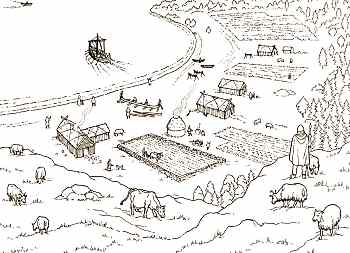 |
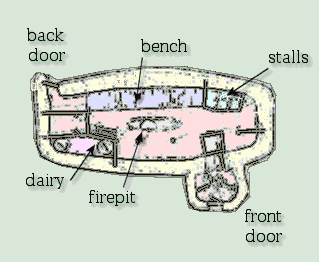 |
In the earlier part of the Norse period, it appears that everything was contained in the longhouse: animals, people, tools, food storage, work shop. Later, all but the people were moved to out buildings. For example, the early longhouse recently excavated at Aðalstræti 14-16 under the streets of Reykjavík had animal stalls in the living quarters. The floor plan of the house (left) shows the animal stalls located opposite to the front door. While this arrangement was common in early longhouses found in Norway, this is the first example found in Iceland. Farmhouses generally were built on a slope or other high ground, which provided for better drainage. Houses were built near running water. While wells (right) were known and used in the Viking age, especially in densely settled areas like trading towns, running water was preferred at a farmstead. |
 |
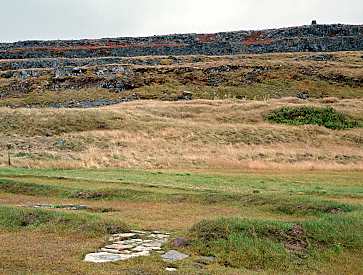 |
The late Viking-age farm at Stöng (right) was built at the top of a hill above a stream, an excellent location. Today, a modern building covers the ruins of the farm on top of the hill. A high location also allowed for better visibility. It was better to see visitors well before they arrived at the farmhouse, should the visitors not be friendly. The Viking-age farm at Vatnsfjörður (left) could light signal fires on the ridge above the house to call for help to neighboring farms, should assistance be required. The photo shows the ruins of the longhouse, with paving stones in front of the doorway, and the varða (cairn) on the cliff in the distance where fires were signal fires were lit. Svarfdæla saga (ch. 14) says that Klaufi first built his farmhouse at Klaufanes (Klaufi's point) in north Iceland, near a river, but it was too exposed, so he moved his farm to Klaufabrekka (Klaufi's slope), further up the valley. |
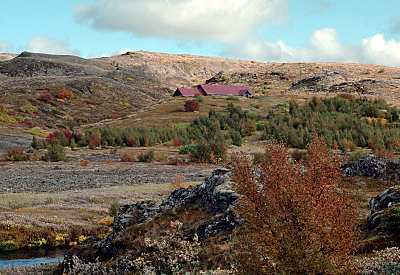 |
The main farming activity throughout the Norse region was animal husbandry, and cattle were the most important of the livestock. That importance is reflected in the language: the word for cattle and the word for money are identical: fé. Cattle were the only farm animals covered by the insurance provided by the hreppur, described later in this article.
Cattle were raised for many purposes. Milk cows provided diary products, which were consumed fresh, but more importantly, they were turned into foods such as cheese, butter, and skyr, which could be stored over the winter months when cows stopped producing fresh milk. On prosperous farms, beef from the cattle was a regular part of the diet. Oxen were used as draft animals, to pull a sleigh, a sledge, or an arðr , an early form of plow. Additionally, bulls were used as offerings to the gods in pagan era sacrifices.
 |
The large, wealthy farm at Stöng in Iceland had a barn with stalls for 18 head of cattle when the farm was destroyed by a volcanic eruption in the year 1104. The ruins of the cow shed are shown to the left, as it appears today. Stone slabs that divided the stalls are still visible (right). Njál's farm at Bergþórshvoll had stalls for 30 head of cattle, a very large Viking age farm. |
 |
Cattle were smaller in the Viking age than today, standing less than 120cm high (48in) at the shoulder. Few bulls were kept. Rather, they were allowed to reach puberty, bred widely, and then slaughtered before they reached the point where they consumed large amounts of fodder in the winter.
In the summer, cattle were driven to pastures in the highlands. Barren cattle might be grazed outdoors year round, but generally milk cows were brought in under cover during the winter and fed from the stored stocks of hay. During especially harsh winters, it is likely that livestock left outdoors starved to death.
Second in importance to Viking age farmers were sheep. Sheep were raised for their fleece, their milk, and their meat. Wethers (castrated rams) were allowed to graze, but ewes were penned and the lambs weaned from them. Smaller numbers of ewes than wethers were kept, which suggests that the fleece from mature wethers was the desired product and that milk from sheep was of lesser importance than it came to be after the end of the Viking age.
|
Like the cattle, the sheep were driven to higher pastures in summer, where they were allowed to roam free. In the fall, all the farmers in a region worked together to round up the sheep and sort them by owner. This practice is still followed in Iceland; the sorting pen shown to the right differs little from those used in medieval times. In winter, some sheep may have been sheltered in barns or simple barrows (fjárborgir). Sheep in the Viking age were about 60cm (24 inches) high at the withers and weighed about 35kg (80lbs). |
 |
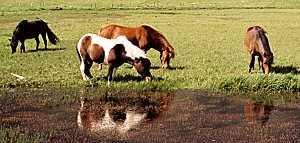 |
Horses were raised, not only for their utility for travel and transport, but also because their meat was prized. It was a common, inexpensive part of the diet. In addition, horses were sacrificed to the pagan gods, and the meat consumed as part of the feasting ceremonies. When Christianity was adopted, the consumption of horseflesh was banned. |
|
There appears to have been special interest in breeding horses in Iceland, perhaps the only farm animal to be systematically bred. Large breeding stocks were kept, with the goal of producing horses that were especially good for the popular sport of horse fights. Viking age horses closely resembled modern Icelandic horses (right). They're small (15 hands, about 150cm), but sturdy, strong, and willing. |
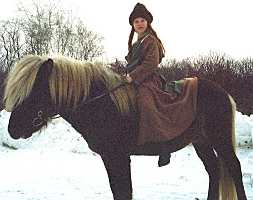 |
Other livestock raised on Viking age farms included goats and pigs. Goats could be grazed year round in areas of brushwood, but evidence from Hofstaðir suggests that goats were penned and fed high quality fodder. Goats were kept for their milk and their meat. In Iceland, pigs were valuable to the early settlers because they reproduced rapidly and were capable of finding food on their own. But because of their destructive tendencies and aggressive behavior, pigs were considered "problem animals" in the later Icelandic law codes. Home field pigs (túnsvín) were kept close to home and slaughtered for home consumption. Very young suckling pigs were considered a delicacy and a mark of status. Many of the pigs kept at Hofstaðir were slaughtered at this stage in their lives, suggesting they were a part of the feasting activities of the farm.
 |
No doubt other domesticated animals were kept, as well. The sagas tells us that dogs were kept to warn of intruders (Brennu-Njáls saga, chapter 76) and were used to track men who were fleeing their pursuers (Reykdæla saga og Víga-Skútu, chapter 4). One might expect that they were used to help round up sheep, as well. Viking-age dogs resembled modern Icelandic dogs (left), a medium-small breed. Cats are rarely found in the literary sources or in archaeological sources, but it seems likely that they were kept to help control pests such as mice around the farm. The sagas occasionally mention cat-skin being used for garments, such as for gloves and for hood-linings (Eiríks saga rauða chapter 4). Archaeological evidence confirms the stories. Cat skeletons have been found on Viking-age house sites having marks consistent with skinning. |
|
The growing of hay was essential to maintain the farm animals over the winter in Norse lands. Hay was required for the animals that were sheltered under cover over the winter, and hay may have been provided to livestock in pasture lands for animals that were out of doors through the winter. As a result, it was necessary to put up sufficient hay each autumn to maintain the livestock until spring. At the beginning of the winter, the number of livestock was compared to the amount of hay in storage. If the farmer thought that insufficient hay was available, the weakest animals were slaughtered before the winter started, so that the available fodder would last the winter. Over two tonnes (2 tons) of hay was needed for each cow to last the Icelandic winter. A large farm in Viking age Iceland had around 20 to 40 milk cows, so harvesting and storing sufficient hay to last the winter was an arduous but important task. Studies of several Viking era farms in north Iceland suggest that farms could produce between 0.5 and 0.9 tonnes of hay per hectare (0.22 - 0.44 tons/acre) in good years. These figures imply that large farms required 20 to 80 hectares (50 to 200 acres) of land set aside for hay cultivation to keep their livestock over the winter. Sheep and goats, being hardier, could survive the winter outside, but might be brought under cover at the height of a storm. While hay was grown on uncultivated land, the best hay was grown in the tún, the home field near the farm. This hay was carefully cultivated, with animals (and people) excluded so that the grass remained untrampled and uneaten while it grew during the summer. |
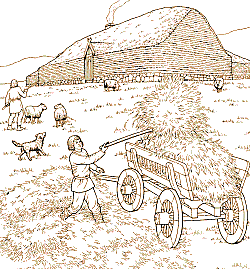 |
 |
Hay was harvested using scythes, and then raked and turned and stacked against a wall for drying. Scythes needed frequent resharpening in order to keep the edge sufficiently sharp. Whetstones, imported from Norway, were used to keep the edge sharp. In addition, the ropes (ljábönd) which attached the blade to the wooden handle worked loose as the work progressed, requiring a pause to retighten. As much hay as possible was stored under cover in barns, but it's likely that at least some of the hay had to be stored outdoors over the winter. This hay was built into stacks and protected from the weather by turf piled around and over the stacks. The tún at Bjarg, the farm where Grettir the Strong was raised, is shown to the left as it looks today. When the photograph was taken, the haying operation was in full swing, using modern farm machinery. |
|
|
An experimental hay harvest, using traditional tools and methods, was recently conducted by Minjasafn Austurlands. The photo to the left shows Gráni loaded with hay in a klyfberi (pack-saddle). It appeared that Gráni ate more hay than he carried on his back. During the second harvest (right), the pack-saddle on Hringur's back was much more heavily loaded. |
 |
|
In order to keep out animals, walls were built of sod and stone. The walls both enclosed and protected the hayfields, and also marked boundaries. A turf wall is shown to the right, which was under construction when the photograph was taken. Building and maintaining the walls surrounding the meadows and the homefield was a major chore at the farm every year. The law required that walls be the shoulder-height of a man and five feet thick at the base (Grágás K 181). Maintaining the walls was so important the law code specified that three months out of each year were to be set aside for the maintenance of walls. Chapter 15 of Fljótsdæla saga tells of a master wall-builder, Ásbjörn, who built boundary walls and hayfield walls in the East Fjords. The saga author says that some of his walls were still standing centuries later when the saga was written. All available manure was spread on the homefield to fertilize the soil and to maximize the crop. In the spring, manure that had accumulated in the animal shelters over the winter was spread on the homefield. There is some evidence that some fields were irrigated, for example the laws about irrigation that appear in Grágás (K 191), the medieval Icelandic law book. However, if irrigation happened at all, it must have been on a small scale, due to the difficulty of digging extensive irrigation ditches with the tools available in the Viking age. Hay was so important to Viking age farms that growing sufficient hay was written into the law, which required that tenant farmers hire enough farm hands that all hay meadows could be worked. The law prohibited land from becoming waste through lack of attention. |
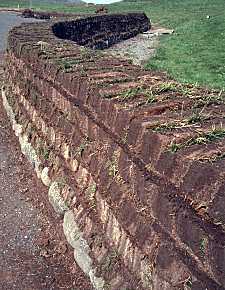 |
In the summer months, livestock was driven to pastures at higher elevations, called sel (shieling). During this time, from mid-June through mid-October, most of the livestock were left to forage freely, while milk cows and ewes were kept close so they could be milked every day. The raw milk from the animals was collected and processed in a shed on site, where the farm family, or their hired hands, lived during the summer while they tended the livestock.
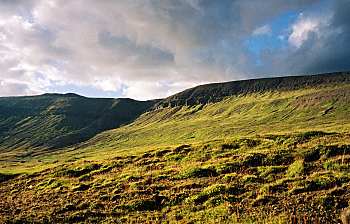 |
In some cases, the sel was near the farm, in the same valley, but further in the valley or higher up the wall of the valley. The sel for Bolli's farm in the Sælingsdalur valley was located adjacent to the ravine Stakkagil (left), as told in Laxdœla saga. Although at the time of the saga, the valley was wooded, it's possible that the farm was visible from the sel. Chapter 55 of the saga says that while working at the sel with only his wife and a few farmhands to help, Bolli was attacked and killed. |
|
In other the cases, the sel was a considerable distance from the farm, perhaps in the next valley, or in the highlands between valleys. The sel ruins shown to the right were discovered in 2004. They are probably the remains of a sel for one of the farms in Hrafnkelsdalur in east Iceland. Perhaps it is one of the sels that Einar rode to in search of the lost sheep, as described in chapter 5 of Hrafnkels saga. The site was studied in 2006, but little conclusive was found. The next year, the site was flooded by Hálslón, the lake behind the new dam at Kárahnjúkur. |
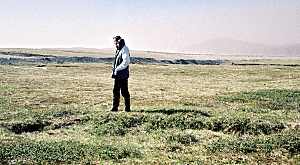 |
 |
Milk collected at the sel was turned into butter, cheese, and skyr on-site. Skyr (left) is usually translated as curds, which for most English speakers, fails to convey the pleasures of this yummy dairy treat. |
|
The dairy products were brought down to the farms in skin sacks. Products such as skyr were stored in partially buried vats (right), which kept the skyr cool, helping to preserve it. During the winter months, when cows stopped producing milk, the skyr in storage became the main source of dairy food. In addition, sour milk was used as a preservative for other foodstuffs. |
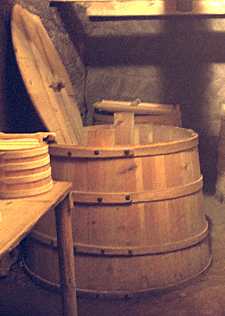 |
Typical crops included grains such as barley (a staple crop throughout the Norse lands), rye, and oats. In the most southerly regions, wheat could be grown, a luxury crop. Depending on the local climate and soil conditions, vegetables such as beans, peas, cabbage, and onions could be grown. Thus, it was possible for a Norse farm family to have a varied diet. In addition, utility crops (such as flax for linen) were grown.
 |
In Iceland, grain cultivation must have been difficult even in the best of times. The best chances for success were in the warmer parts of the country, in the south and southwest. Njáls saga, set in the south, contains a number of references to the growing of grain. Chapter 111 tells that Höskuldr Hvítanesagoði went out one morning with his seed bag in one hand and his sword in the other to sow grain in his field (left, as it appears today). The sons of Njál were waiting behind the fence, and they ambushed Höskuldr and killed him. |
Regardless, grain cultivation was clearly attempted by the early Icelandic settlers. Both oat and barley pollen and barley grains have been found in the earliest settlement layers in Iceland. Substantial quantities of grain were found in the excavation of a Viking age granary at Aðalstræti 14-16 in Reykjavik, suggesting that at least for this early Viking age farm, grain cultivation was quite successful. If the stone chest had been full, it would have held 200kg (440lb) of grain.
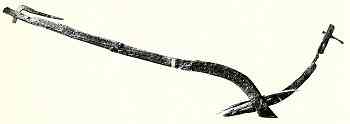 |
Larger grain fields were plowed with an arðr (left) drawn by oxen, while smaller fields were worked with hand tools. The iron cutting piece of the arðr (right) lacked flaring sides, so it merely cut grooves into the soil, rather than turning the soil like a modern plow. In the photo, the cutting tip is to the left, and the opening that receives the wooden frame of the arðr is to the right. |
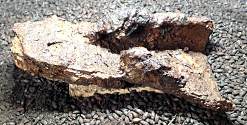 |
Plows were used in other parts of Europe during the Norse era, but there is scant evidence of their use in Norse lands during this time. Literary evidence (such as Landnámabók) supports only the use of ards. While iron cutting blades of ards have been found, no complete ards or plows are known to have survived from the Norse era, so their appearance is open to speculation.
It is thought that one man guided the arðr while another walked alongside the oxen, guiding them, encouraging them, and holding them when the arðr was stopped by a stone.
|
Sometime in the 11th century, a drift of sand covered a farmer's field in northern Jutland. When the sand was removed in the 1950s, the Norse era field was still intact from its last plowing (right). The slightly curving furrows can be seen, along with the tracks of a wheeled vehicle, and footprints, possibly those of the farmer who plowed the field. |
 |
Continuous cropping was the cultivation practice most widely followed, where fields were continuously used year after year without any fallow periods. This practice required heavy fertilization in the form of manure. Only later in the medieval period, after the end of the Viking age, did crop rotation techniques come to be used in Norse lands. It is possible that alternating fields were left fallow for a year, and livestock were kept overnight on the unfallow fields as a way of fertilizing the field for the next year's crop.
Barley was mowed with a sickle, then bound and stacked. After drying near a fire, the grain was threshed. The difficulty of growing grain was reflected in its value. A weight of dried grain was worth the same as an equal weight of butter or cheese. Grain was used for bread, porridge, and ale.
 |
Various tools were widely used for cultivating, harvesting, and processing the crops. Iron-shod spades (left) with a wooden blade and handle, and only a thin iron edge were used to dig ditches. Iron picks and iron-shod hoes were used to work the soil. Iron scythes, sickles, and leaf-knives were used for harvesting. Wooden pitchforks and rakes (right) were used for spreading manure and for haymaking. Manure was also spread by dragging bundles of sticks over the homefield to break up and spread out the clots of manure. Flails were used to thresh the grain. Stone querns (below) were used to mill the flour (although archaeological evidence suggests that water powered mills might have been used in towns during the Viking era).
|
 |
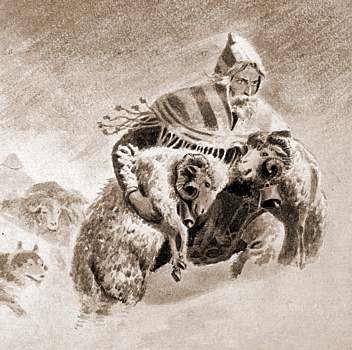 |
The farm staff typically consisted of the owner of the farm, his family, as well as extended family who lived with the farmer in the longhouse. In addition, hired men and servants worked at the farm, in exchange for wages and room and board. Most farms kept slaves, a practice that was widespread throughout the Viking lands on both large and small farms. Slaves generally worked alongside the hired workers on the farm, but probably were assigned the harder and less desirable work. Lastly, shepherds were hired to tend the sheep, but this work had little respect. The low status of shepherds is revealed in several sources. Shepherds received no wages, but only room and board. The law (Grágás K.78) prohibited farmers from assigning shepherding duties to the hired men, which would be demeaning. In chapter 26 of Reykdæla saga og Víga-Skútu, Skúta pretended to be a shepherd while he was being pursued. He turned his cloak inside-out (to display the less showy inner lining), broke off the spearhead from its shaft (turning it into a staff and appearing weapon-less), and took the saddle off his horse (to appear poor). Riding bareback, Skúta shouted at the sheep as he rode towards his pursuers. As he passed, they didn't recognize him as the imposing man with weapons they had been chasing. |
The law in Iceland required every person to be affiliated with a farm. In order to bring a legal complaint against a person, he had to be summoned to the legal assembly (þing) for his region. A person with no fixed abode couldn't be charged in the proper court and thus was a danger to the smooth operation of society. People were allowed to change their legal residence only during the four days at the end of May called fardagar (moving days). During this time, households moved, and tenants and farmhands renewed their contracts for the year.
|
Occasionally, men did not want to move. Chapter 26 of Víga-Glúms saga says that Einarr won a case against Glúmr. Glúmr was banished from the district, and Einarr bought his land. On the last of the moving days, Glúmr sat in his high seat and refused to leave his home. Einar's mother came and turned him out. "You can't stay any longer. I turn you out now, for the land is consecrated to Einarr." Glúmr's farm at Þverá is shown to the right as it appears today. |
 |

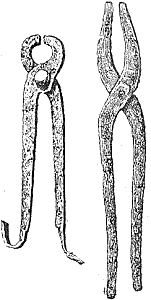 In
general, farm families needed to be self-sufficient. With the
exception of some luxury items, and some raw materials, everything
needed for farm life was typically grown or manufactured on the
farm. Wooden tools were made as needed. Every farm had to have a forge of some
kind in order to be able to resharpen cutting tools such as scythes; whetting
alone was insufficient for keeping frequently used tools sharp. Most large farms had
well equipped forges
for working iron. Farmers were expected to be competent carpenters
and blacksmiths. The tools shown to the left are reproductions of carpenter
tools (top) and blacksmith tools (bottom). Sketches of period blacksmithing tools are shown to the right.
In
general, farm families needed to be self-sufficient. With the
exception of some luxury items, and some raw materials, everything
needed for farm life was typically grown or manufactured on the
farm. Wooden tools were made as needed. Every farm had to have a forge of some
kind in order to be able to resharpen cutting tools such as scythes; whetting
alone was insufficient for keeping frequently used tools sharp. Most large farms had
well equipped forges
for working iron. Farmers were expected to be competent carpenters
and blacksmiths. The tools shown to the left are reproductions of carpenter
tools (top) and blacksmith tools (bottom). Sketches of period blacksmithing tools are shown to the right.
Farms throughout the Norse lands were isolated. Farm life in the Viking age was a constant struggle against starvation, cold, and disease. Most people expected to and did work their entire waking hours.
Since there was nothing like a police force to maintain the peace, every farmer had to be prepared to defend his farm and property. A sense of solidarity was expected on a farm, between the farmer and his wife, on one hand, and the servants and farm hands on the other. In exchange for obedience and support, the farmer provided for defense and safety of his entourage. In addition, a farmer would look for support and assistance from people outside the farm: from family members; his chieftain; his neighbors; and others with whom he had made reciprocal arrangements for mutual help and protection.
In Iceland, each local district participated in a mutual insurance pact, called a hreppr. Regular annual payments from area farmers were used to help farms that suffered catastrophic losses to buildings from fire or to livestock from disease. The hreppr also saw to the welfare of orphans or others who could not provide for themselves. While the concept of the hreppr is discussed in the law books (Grágás K234), it is mentioned only once in passing in the stories (Víga-Glúms saga, chapter 18).
It was the custom of farmers in a district to meet during the last month of the winter, according to chapter 14 of Vopnfirðinga saga. At these meetings, men shared out the common work that needed to be done in the spring.
Entertainment was at a premium at the farm, and included games, feasts,
and story telling. Any opportunity to travel to markets, to feasts, to games, or to
gatherings such as þing meetings was welcome.
|
|
©1999-2026 William R. Short |